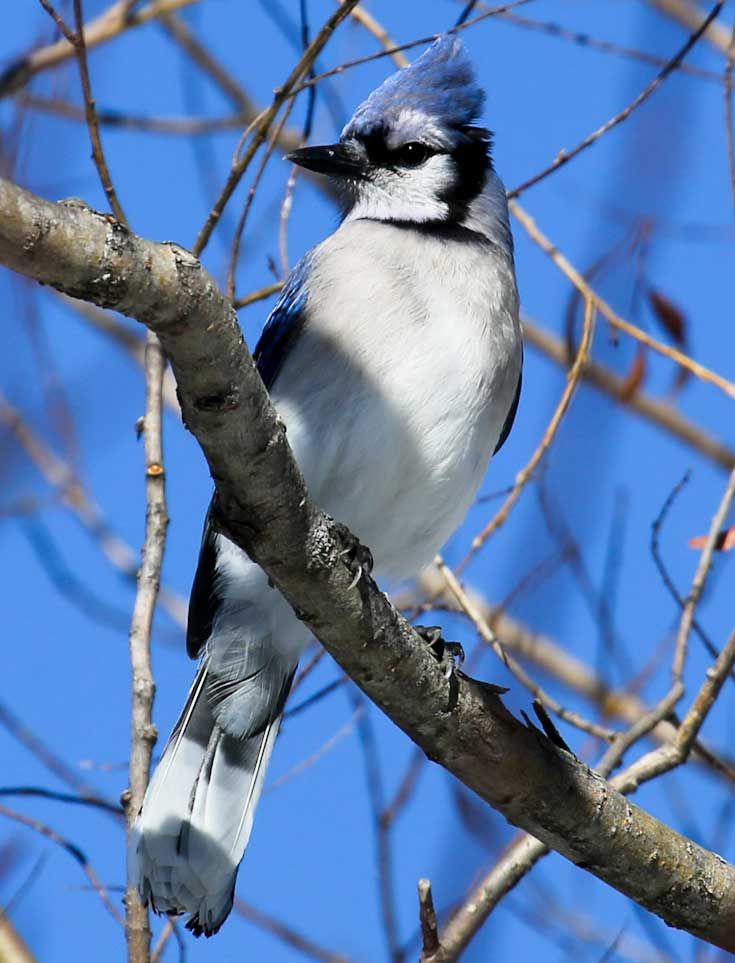Interesting, that at a time of year when warblers, vireos, orioles, and other songbirds are streaming into and through the state for their spring migration back from warmer climes, the Maine Birds listserv is abuzz about…Blue Jays.
We once overheard someone in another state declare the Blue Jay to be the most beautiful of all birds. Not a bad claim to fame, when you consider they’re competing with about 10,000+/- other bird species. Nonetheless, it’s easy for us Maine birders to be complacent about Blue Jays, given that we can see them here just about anywhere, any time of year. We think of them as permanent residents, which as a species, they are.
Which ties in to why the listserv is chirping.
Birder after birder after birder after birder has been sharing their observations about big migrations of Blue Jays over the last week. This is how the conversation went:

Blue Jay in Alton, Maine, by David Small
“At Schoodic Point today I observed a cohesive band of northward-flying Blue Jays, around 27 of them. They stuck together, seemed intent on moving on, and briefly alit in some conifers. Anyone else seen Blue Jay movements like this? If so, I’d appreciate a share.”
“My goodness, yes. I’ve seen 30+ doing the same thing multiple times over the last week. By my observation, a lot of Blue Jays left the state this winter, and they’re wicked late flocking back in. Apparently, chickadees are doing it, too.”
“I’ve been noticing the same thing over the past few weeks.”
“On Monhegan round 9:30 a.m., Friday May 19, Betsy and I observed a group of 35-40 jays moving northwesterly above the boreal forest north of the village. Over the next couple or more minutes there were individual jays moving generally in the same direction the group had taken.”
“At Schoodic on Saturday, Blue Jay flocks of 40, 17, 13, 8, and stragglers by 1 or 2s. All during morning from 6:15 to 9:30.”
It should come as no surprise that some of the greatest mysteries of the bird world are held by our most common and familiar birds. For example, many people are surprised to learn that Blue Jays migrate. That’s because most Blue Jays don’t migrate.

Sometimes, common birds are the ones that are the most mysterious—Blue Jays, for example. Photo courtesy of Jeff Wells.
Birders have long known that in both spring and fall, it’s not uncommon to see flocks of these high-flying blue birds (not to be confused with bluebirds) clearly zipping off in migration. In fact, at official hawk watches, observers often keep tally of the number of Blue Jays passing by overhead along with the hawks. The numbers can sometimes (especially in fall migration) be in the thousands at certain spots daily during the height of migration. That’s a hefty number, putting them right up there with some of the more “traditional” migrants.
However, unlike many of those species, Blue Jays, as far as we know, only migrate during the day, like their Corvid cousins, American Crows.
Adding to the mystery is this: According to the Blue Jay account in Cornell’s “Birds of the World,” it’s still unknown whether or not most migrant Blue Jays are young birds. Banding station captures during migration in some years seem to have lots of young jays—but not in every year.
It’s also not yet known as to whether there is a component of the population that migrates every year from every part of the range or whether movements are related to food abundance changes in some areas in some years. We have wondered whether it may be that birds along the northern edge of the Blue Jay range within the Boreal Forest biome of Canada could be the ones that vacate that very cold area each winter. But there is no clear evidence for that being the case.

Photo by David Small
And despite the large numbers of Blue Jays that are seen migrating south each year, even into Florida and across into Gulf Coast states and Texas, there has never been a documented record of the species from Mexico or the Caribbean (according to “Birds of the World,” at least). Interestingly, there is a photographic record in eBird of a Blue Jay coming to a feeder in south Texas, just barely across the Rio Grande River from Mexico. The species has been documented down into the Florida Keys, but never in Cuba, less than a hundred miles farther south.
The only two records outside the U.S. are said to be from Bermuda, although the “Birds of the World” species account points out that neither of these records was documented by photographs or specimens, which would seem to suggest that those records may be suspect.
New migration tracking technologies are just beginning to be applied to understand more about the prevalence of migration in different Blue Jay populations and other aspects of their migration ecology. We can’t wait to hear the results to reveal more of the hidden mysteries of this fascinating and familiar bird.
—Jeff and Allison Wells












Had a blue jay at my feeder this morning. Loved watching it! We don’t see them much. South Louisiana
Blue Jay cruising around my
backyard this morning in Catonsville, MD.
Bunch of them here in reno beach ohio
Over one hundred and fifty jays have passed( in five minutes)southeast this morning. It usually happens here one day or two in fall. I stopped counting, but it’s been super continuous all morning So I would extrapolate up into the thousands! St Joseph ON on Lake Huron.
Used to notice a day like this in Scarborough near Lake Ontario in the past. A large number going your direction perhaps.
Hi, Julie,
Large bodies of water like that are great places to watch spectacular migrations – what a treat!
Thank you so much for sharing your observation!
Good birding,
Allison and Jeff
I’ve got peanuts out to attract Blue Jays here in Milwaukee but they haven’t arrived yet as of October 4th. Usually I get dozens. It may be too early.
We’re not far from you(as a bird flys..LOL) close to Grand Rapids and been watching their antics all morning. They love their peanuts.
Thirty years in Atlanta and today was the first time that I spied a pair of blue jays in our oak tree. Acorns are bountiful this year.
I feed the squirrels nuts. Pecans, cashews, walnuts and unshelled peanuts.
This winter, a flock of at least 6 have vied for the nuts, with one calling to the others that
the nuts are out. They will even swoop up to the steps to retrieve a nut.
Too large to swallow whole, what the Blue Jays do, is take the nut back up to a tree,
hold it down with their claws and peck away for the fare.
This is a much easier way for the Blue Jays to “get their fair share” than
pecking their way at a bird feeder.
They are lazy, but smart birds, indeed!
I live in southern North Carolina.
On April 24th right on schedule as we’ve seen in many years since we moved to Ohio flock of jays came in. I immediately got my unsalted peanuts out and fed them. They usually stay around here from no longer than about a week they are great entertainment for my cats and I think they’re happy to see them go